Saturday, 23 April, 2011. 10:17
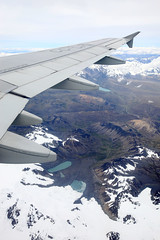 We are on our flight from Lima to Puerto Maldonado, with a stop in Cusco on the way. We got up at 05:50 to get the breakfast Ale had said would be arranged for us at 06:00. But there was nobody else there and only bread rolls and a jug of orange juice there – no fruit or cereal or yoghurt. We had some bread rolls with our malaria tablets, and a guy came out to put plates of ham and cheese out – he looked surprised to see us there. We went to pack our bags and be downstairs by 06:45 for our bus to the airport with the others, except for Lyn and Gary, Zaina and Zeeshan, who were booked on a later flight and so got to sleep in. Our bonus for getting to Puerto Maldonado before them is a short trip to a local market before we meet up with them before our boat trip to the jungle lodge.
We are on our flight from Lima to Puerto Maldonado, with a stop in Cusco on the way. We got up at 05:50 to get the breakfast Ale had said would be arranged for us at 06:00. But there was nobody else there and only bread rolls and a jug of orange juice there – no fruit or cereal or yoghurt. We had some bread rolls with our malaria tablets, and a guy came out to put plates of ham and cheese out – he looked surprised to see us there. We went to pack our bags and be downstairs by 06:45 for our bus to the airport with the others, except for Lyn and Gary, Zaina and Zeeshan, who were booked on a later flight and so got to sleep in. Our bonus for getting to Puerto Maldonado before them is a short trip to a local market before we meet up with them before our boat trip to the jungle lodge.
At the airport, I asked Ale if my sandals would be okay for the jungle, or if I needed closed shoes. She said the sandals were perfect, which was good because I wasn’t keen on wearing the newly bought tight shoes.
18:10. Corto Maltes jungle lodge.
We are having a rest after our first introduction to the Amazon jungle!
 Our flight landed in Puerto Maldonado around 12:00. The flight took us over the Andes and we saw several snow-capped peaks which gave way to a carpet of green that was the jungle. The sky was full of fluffy white cumulus and we landed in sunshine. I said, “At least it’s not raining like on Baltra…” and then it started raining. Lightly at first as we waited for the plane to open up, but then heavily as the steps were wheeled up to the doors. We had to dash a hundred metres across the tarmac in the rain to the terminal. But this terminal at least had a luggage carousel, even if we could see the one guy in the one luggage tractor going back and forth making about four trips to the plane before he’d delivered all the luggage.
Our flight landed in Puerto Maldonado around 12:00. The flight took us over the Andes and we saw several snow-capped peaks which gave way to a carpet of green that was the jungle. The sky was full of fluffy white cumulus and we landed in sunshine. I said, “At least it’s not raining like on Baltra…” and then it started raining. Lightly at first as we waited for the plane to open up, but then heavily as the steps were wheeled up to the doors. We had to dash a hundred metres across the tarmac in the rain to the terminal. But this terminal at least had a luggage carousel, even if we could see the one guy in the one luggage tractor going back and forth making about four trips to the plane before he’d delivered all the luggage.
From there we were taken by minibus to the Corto Maltes office in town. There, people with large luggage left it behind, bringing a smaller pack for two nights in the jungle. The guy looked at our backpacks and laughed and said we could just take those. Which is good because we didn’t have to figure out what to take and what to leave. Although we’d been promised a trip to the market, this didn’t eventuate as various logistics with the luggage were worked out. Instead we got to walk down the dusty street a bit to a lookout over the Rio Madre de Dios – the largest tributary of the Amazon. It was an impressive wide ribbon of brown water running through the jungle. Soon after, the late members of the group arrived and we reassembled.
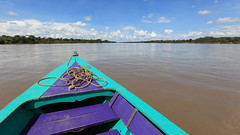 From the office in Puerto Maldonado, it was another short bus trip to the dock on the river. There is a large suspension bridge being built across the river an I asked our local guide, Sai, if that was a replacement bridge or a new one where there had been no bridge before. Sai said it was the first time a bridge across the river had been built here, and it was part of a cooperative project between Peru and Brazil to build a cross-continental road. He said it had been under construction for three years and the government says it will be finished this year, but he didn’t believe it. I told him it was just like building projects where we lived!
From the office in Puerto Maldonado, it was another short bus trip to the dock on the river. There is a large suspension bridge being built across the river an I asked our local guide, Sai, if that was a replacement bridge or a new one where there had been no bridge before. Sai said it was the first time a bridge across the river had been built here, and it was part of a cooperative project between Peru and Brazil to build a cross-continental road. He said it had been under construction for three years and the government says it will be finished this year, but he didn’t believe it. I told him it was just like building projects where we lived!
We piled on a wooden boat with a sun roof and a fan propeller like Thai canal boats. Sai insisted we put on life jackets, but said if we were too hot we could take them off after we departed the dock. They had to make us wear them at least near the town or they would get into trouble with the police. We quickly took them off as soon as he said we could because they were stifling in the humid heat.
21:20
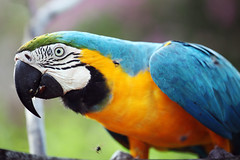 Corto Maltes Lodge is quite a swish place for being in the middle of the Amazon jungle. It has a bar, gift shop, dining room, and a diesel generator that produces power from 07:00 to 10:30, 12:00 to 14:00, and 17:30 to 22:30. At other times there is no power. There are about 20 or 30 bungalows, each with a bathroom with a selection of cold or cold water. There are mosquito nets over the beds and the air conditioning consists of insect-mesh-covered windows.
Corto Maltes Lodge is quite a swish place for being in the middle of the Amazon jungle. It has a bar, gift shop, dining room, and a diesel generator that produces power from 07:00 to 10:30, 12:00 to 14:00, and 17:30 to 22:30. At other times there is no power. There are about 20 or 30 bungalows, each with a bathroom with a selection of cold or cold water. There are mosquito nets over the beds and the air conditioning consists of insect-mesh-covered windows.
The first thing we did was to claim some rubber boots for a later walk through the forest, which Sai said would be muddy with the rain. Near the boot collection area were two bright macaws, one red and green, the other yellow and blue. They are pets of the lodge and seem to have their wings clipped. There were also two immature green parrots as well.
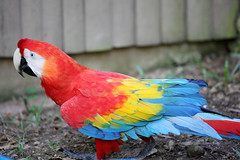 We found our bungalows and unpacked some stuff before a brief rest in hammocks on the front porch. Then I decided to take a swim in the pool, which turned out to be a green colour, and had lots of bugs floating in it. But a woman there, not from our tour group, jumped in and a man said it was fine for swimming, but the water was a bit warm. indeed it was, like a warm bath, but still better than the oppressively hot and humid air. I swam a few half-hearted laps, then found a hose stuck in the pool and checked it out. It turned out to be delivering deliciously cold water, so I spent the next ten minutes dribbling it over myself rather than swimming.
We found our bungalows and unpacked some stuff before a brief rest in hammocks on the front porch. Then I decided to take a swim in the pool, which turned out to be a green colour, and had lots of bugs floating in it. But a woman there, not from our tour group, jumped in and a man said it was fine for swimming, but the water was a bit warm. indeed it was, like a warm bath, but still better than the oppressively hot and humid air. I swam a few half-hearted laps, then found a hose stuck in the pool and checked it out. It turned out to be delivering deliciously cold water, so I spent the next ten minutes dribbling it over myself rather than swimming.
After the swim, I drip dried and Olivia and Laura and Kim came by, photographing bits of the garden. They saw a spider in a web – Olivia kept exclaiming, “Yuk! It’s disgusting!” and stepping closer and closer for photos. I jumped down from the pool deck to have a look and found it no bigger than an orb spider in Sydney. I tried to take the log step back up to the pool deck but stubbed my toe on the concrete, bending the nail and causing a bit of bleeding. Unfortunately earlier Ale had said tomorrow we could swim in a lake with piranhas, which were harmless, as long as you weren’t bleeding.
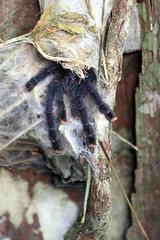 I covered my wound with a band-aid before donning the rubber boots for the walk in the jungle. This was an interpretive walk with Sai telling us about the plants of the jungle mostly, but also some of the animals. Indeed our first stop, barely ten steps past the last bungalows, was at a palm tree where he poked a stick into a tangled mass of webs and a huge tarantula leaped out to attack it. It was the size of a large human hand, with thick black hairy legs. Sai said its venom was harmless to humans but their bite would hurt like a bee sting, simply because the fangs were so large. He said the most dangerous thing about them were the hairs, which they can shed if threatened, and they can get into your skin and irritate it for days. Or if you get one in your eye it can temporarily blind you. (Later we were to discover that all of the palm trees growing close to our lodges were completely covered in masses of identical looking webs…)
I covered my wound with a band-aid before donning the rubber boots for the walk in the jungle. This was an interpretive walk with Sai telling us about the plants of the jungle mostly, but also some of the animals. Indeed our first stop, barely ten steps past the last bungalows, was at a palm tree where he poked a stick into a tangled mass of webs and a huge tarantula leaped out to attack it. It was the size of a large human hand, with thick black hairy legs. Sai said its venom was harmless to humans but their bite would hurt like a bee sting, simply because the fangs were so large. He said the most dangerous thing about them were the hairs, which they can shed if threatened, and they can get into your skin and irritate it for days. Or if you get one in your eye it can temporarily blind you. (Later we were to discover that all of the palm trees growing close to our lodges were completely covered in masses of identical looking webs…)
From the tarantula, we walked straight out into the depths of the jungle. Sai stopped periodically to tell us about various trees along the way, and a few times to point out animals. He showed us termites who nest high in a tree and build covered tunnels on the mark to move up and down the tree. He broke a tunnel open and showed us the soldier termites racing to protect the breach. He said you can eat them, and demonstrated. I tried one and it had a faint woody taste. He said within a few hours, worker termites would rebuild the tunnel.
 He showed us a nest of ants in a lemon tree, who became agitated when he tapped the tree. He later found some enormous ants, the so called bullet ants, that were simply huge – a good 3 centimetres long and with chunky bodies. These lived underground in a nest Sai identified, then tapped to provoke a few to appear. He picked up one on a stick and carefully juggled it as he spoke to make sure the single ant on it didn’t get near his hands. He said he’d been bitten three times in his life by one, and he remembered the excruciating pain from each one. Further on, we found yet another type of ant – the fire ant – which lived in symbiosis with a tree. The ants keep the tree clear of other plants, as he demonstrated by laying a crushed leaf on the trunk, and as we watched the ants appeared and hauled it away. He said these ants stung too, but on or two was okay, although more than about ten stings could cause a fever.
He showed us a nest of ants in a lemon tree, who became agitated when he tapped the tree. He later found some enormous ants, the so called bullet ants, that were simply huge – a good 3 centimetres long and with chunky bodies. These lived underground in a nest Sai identified, then tapped to provoke a few to appear. He picked up one on a stick and carefully juggled it as he spoke to make sure the single ant on it didn’t get near his hands. He said he’d been bitten three times in his life by one, and he remembered the excruciating pain from each one. Further on, we found yet another type of ant – the fire ant – which lived in symbiosis with a tree. The ants keep the tree clear of other plants, as he demonstrated by laying a crushed leaf on the trunk, and as we watched the ants appeared and hauled it away. He said these ants stung too, but on or two was okay, although more than about ten stings could cause a fever.
Apart from ants, we also saw an agouti through the undergrowth, and on the way back as it was getting dark we saw a group of small night monkeys, a golden orange in colour, and about the size of a small possum.
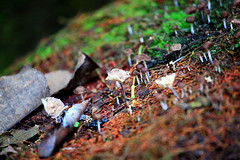 The trees he showed us included a rubber tree, a palm with sharp thorny spikes that the natives used as blowgun darts, a tree that made a purple dye when you crushed the leaves, the “garlic” tree, which had bark that smelled exactly like garlic, a tree whose sap was antiseptic and smelled like Dencorub, and a tree whose stem he broke bits off and got people to chew, saying, “Don’t swallow it, and don’t swallow the juice.” After a few seconds of chewing, everyone could feel tingling in their tongue and lips, and then they went numb. Sai said this was an anaesthetic tree and people with toothache would chew a wad of leaves to kill the pain or even anaesthetise for tooth extraction. We were very careful to spit out the bits we were chewing and all of the juice. He also showed us a strangler fig in the process of killing a large palm tree, and the walking palm, which moves slowly across the jungle to stronger light by growing new roots on one side and letting the ones on the other side die off.
The trees he showed us included a rubber tree, a palm with sharp thorny spikes that the natives used as blowgun darts, a tree that made a purple dye when you crushed the leaves, the “garlic” tree, which had bark that smelled exactly like garlic, a tree whose sap was antiseptic and smelled like Dencorub, and a tree whose stem he broke bits off and got people to chew, saying, “Don’t swallow it, and don’t swallow the juice.” After a few seconds of chewing, everyone could feel tingling in their tongue and lips, and then they went numb. Sai said this was an anaesthetic tree and people with toothache would chew a wad of leaves to kill the pain or even anaesthetise for tooth extraction. We were very careful to spit out the bits we were chewing and all of the juice. He also showed us a strangler fig in the process of killing a large palm tree, and the walking palm, which moves slowly across the jungle to stronger light by growing new roots on one side and letting the ones on the other side die off.
The walk was amazing, and we saw so much different stuff within only 20 minutes or so walk from the lodges. We had to return a little early as it started getting dark, but it was still completely brilliant. It was amazing how dense and alive the jungle was, with so many different and fascinating trees, other plants, insects, and other animals. The scary thing was how impossible it was to tell where you were, even when within spitting distance of the lodge. If we’d lost Sai and wandered off the walking track, it would have been easy to become completely lost and unable to find our way back.
